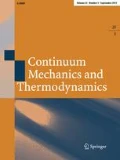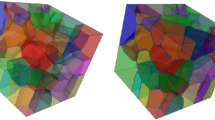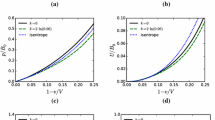Abstract
A continuum mechanical theory is used to model physical mechanisms of twinning, solid-solid phase transformations, and failure by cavitation and shear fracture. Such a sequence of mechanisms has been observed in atomic simulations and/or experiments on the ceramic boron carbide. In the present modeling approach, geometric quantities such as the metric tensor and connection coefficients can depend on one or more director vectors, also called internal state vectors. After development of the general nonlinear theory, a first problem class considers simple shear deformation of a single crystal of this material. For homogeneous fields or stress-free states, algebraic systems or ordinary differential equations are obtained that can be solved by numerical iteration. Results are in general agreement with atomic simulation, without introduction of fitted parameters. The second class of problems addresses the more complex mechanics of heterogeneous deformation and stress states involved in deformation and failure of polycrystals. Finite element calculations, in which individual grains in a three-dimensional polycrystal are fully resolved, invoke a partially linearized version of the theory. Results provide new insight into effects of crystal morphology, activity or inactivity of different inelasticity mechanisms, and imposed deformation histories on strength and failure of the aggregate under compression and shear. The importance of incorporation of inelastic shear deformation in realistic models of amorphization of boron carbide is noted, as is a greater reduction in overall strength of polycrystals containing one or a few dominant flaws rather than many diffusely distributed microcracks.
Similar content being viewed by others
References
Chen, M., McCauley, J.W., Hemker, K.J.: Shock-induced localized amorphization in boron carbide. Science 299, 1563–1566 (2003)
Yan, X.Q., Tang, Z., Zhang, L., Guo, J.J., Jin, C.Q., Zhang, Y., Goto, T., McCauley, J.W., Chen, M.W.: Depressurization amorphization of single-crystal boron carbide. Phys. Rev. Lett. 102, 075505 (2009)
Fanchini, G., McCauley, J.W., Chhowalla, M.: Behavior of disordered boron carbide under stress. Phys. Rev. Lett. 97, 035502 (2006)
Taylor, D.E., McCauley, J.W., Wright, T.W.: The effects of stoichiometry on the mechanical properties of icosahedral boron carbide under loading. J. Phys. Condens. Matter. 24, 505402 (2012)
Taylor, D.E.: Shock compression of boron carbide: a quantum mechanical analysis. J. Am. Ceram. Soc. 98, 3308–3318 (2015)
An, Q., Goddard, W.A., Cheng, T.: Atomistic explanation of shear-induced amorphous band formation in boron carbide. Phys. Rev. Lett. 113(9), 095501 (2014)
An, Q., Goddard, W.A.: Atomistic origin of brittle failure of boron carbide from large-scale reactive dynamics simulations: suggestions toward improved ductility. Phys. Rev. Lett. 115, 105051 (2015a)
Grady, D.E.: Adiabatic shear failure in brittle solids. Int. J. Impact Eng. 38, 661–667 (2011)
Clayton, J.D.: Towards a nonlinear elastic representation of finite compression and instability of boron carbide ceramic. Philos. Mag. 92, 2860–2893 (2012a)
Clayton, J.D.: Mesoscale modeling of dynamic compression of boron carbide polycrystals. Mech. Res. Commun. 49, 57–64 (2013)
Clayton, J.D., Tonge, A.: A nonlinear anisotropic elastic-inelastic constitutive model for polycrystalline ceramics and minerals with application to boron carbide. Int. J. Solids Struct. 64–65, 191–207 (2015)
Li, Y., Zhao, Y.H., Liu, W., Zhang, Z.H., Vogt, R.G., Lavernia, E.J., Schoenung, J.M.: Deformation twinning in boron carbide particles within nanostructured Al 5083/B\(_4\)C metal matrix composites. Philos. Mag. 90, 783–792 (2010)
Sano, T., Randow, C.L.: The effect of twins on the mechanical behavior of boron carbide. Metall. Mater. Trans. A 42, 570–574 (2011)
Clayton, J.D.: Nonlinear Mechanics of Crystals. Springer, Dordrecht (2011)
Clayton, J.D., McDowell, D.L.: A multiscale multiplicative decomposition for elastoplasticity of polycrystals. Int. J. Plast. 19, 1401–1444 (2003)
Kalidindi, S.R.: Incorporation of deformation twinning in crystal plasticity models. J. Mech. Phys. Solids 46, 267–290 (1998)
Barton, N.R., Winter, N.W., Reaugh, J.E.: Defect evolution and pore collapse in crystalline energetic materials. Model. Simul. Mater. Sci. Eng. 17, 035003 (2009)
Clayton, J.D.: A continuum description of nonlinear elasticity, slip and twinning, with application to sapphire. Proc. R. Soc. Lond. A 465, 307–334 (2009)
Clayton, J.D.: Deformation, fracture, and fragmentation in brittle geologic solids. Int. J. Fract. 163, 151–172 (2010a)
Clayton, J.D.: Modeling nonlinear electromechanical behavior of shocked silicon carbide. J. Appl. Phys. 107, 013520 (2010b)
Aslan, O., Cordero, N.M., Gaubert, A., Forest, S.: Micromorphic approach to single crystal plasticity and damage. Int. J. Eng. Sci. 49, 1311–1325 (2011)
Voyiadjis, G.Z., Kattan, P.I.: Damage Mechanics. CRC Press, Boca Raton (2005)
Bammann, D.J., Solanki, K.N.: On kinematic, thermodynamic, and kinetic coupling of a damage theory for polycrystalline material. Int. J. Plast. 26, 775–793 (2010)
Xu, X.-P., Needleman, A.: Numerical simulations of fast crack growth in brittle solids. J. Mech. Phys. Solids 42, 1397–1434 (1994)
Clayton, J.D.: Dynamic plasticity and fracture in high density polycrystals: constitutive modeling and numerical simulation. J. Mech. Phys. Solids 53, 261–301 (2005)
Vogler, T.J., Clayton, J.D.: Heterogeneous deformation and spall of an extruded tungsten alloy: plate impact experiments and crystal plasticity modeling. J. Mech. Phys. Solids 56, 297–335 (2008)
Foulk, J.W., Vogler, T.J.: A grain-scale study of spall in brittle materials. Int. J. Fract. 163, 225–242 (2010)
Hou, T.Y., Rosakis, P., LeFloch, P.: A level-set approach to the computation of twinning and phase-transition dynamics. J. Comput. Phys. 150, 302–331 (1999)
Del Piero, G., Lancioni, G., March, R.: A variational model for fracture mechanics: numerical experiments. J. Mech. Phys. Solids 55, 2513–2537 (2007)
Kuhn, C., Müller, R.: A continuum phase field model for fracture. Eng. Fract. Mech. 77, 3625–3634 (2010)
Clayton, J.D., Knap, J.: A geometrically nonlinear phase field theory of brittle fracture. Int. J. Fract. 189, 139–148 (2014)
Weinberg, K., Hesch, C.: A high-order finite deformation phase-field approach to fracture. Contin. Mech. Thermodyn. 29, 935–945 (2017)
Levitas, V.A., Levin, V.A., Zingerman, K.M., Freiman, E.I.: Displacive phase transitions at large strains: phase-field theory and simulations. Phys. Rev. Lett. 103, 025702 (2009)
Clayton, J.D.: Phase field theory and analysis of pressure-shear induced amorphization and failure in boron carbide ceramic. AIMS Mater. Sci. 1, 143–158 (2014a)
Schmitt, R., Kuhn, C., Müller, R.: On a phase field approach for martensitic transformations in a crystal plastic material at a loaded surface. Contin. Mech. Thermodyn. 29, 957–968 (2017)
Clayton, J.D., Knap, J.: A phase field model of deformation twinning: nonlinear theory and numerical simulations. Phys. D 240, 841–858 (2011a)
Clayton, J.D., Knap, J.: Phase field modeling of twinning in indentation of transparent single crystals. Model. Simul. Mater. Sci. Eng. 19, 085005 (2011b)
Clayton, J.D., Knap, J.: Phase field analysis of fracture induced twinning in single crystals. Acta Mater. 61, 5341–5353 (2013)
Hildebrand, F.E., Miehe, C.: A phase field model for the formation and evolution of martensitic laminate microstructure at finite strains. Philos. Mag. 92, 4250–4290 (2012)
Padilla, C.A.H., Markert, B.: A coupled ductile fracture phase-field model for crystal plasticity. Contin. Mech. Thermodyn. 29, 1017–1026 (2017)
Clayton, J.D.: Finsler geometry of nonlinear elastic solids with internal structure. J. Geom. Phys. 112, 118–146 (2017a)
Saczuk, J.: Finslerian Foundations of Solid Mechanics. Zeszyty naukowe Instytutu Maszyn Przeplywowych Polskiej Akademii Nauk w Gdansku, Wydawnictwo IMP PAN, Gdansk (1996)
Stumpf, H., Saczuk, J.: A generalized model of oriented continuum with defects. Zeitschrift für Angewandte Mathematik und Mechanik (ZAMM) 80, 147–169 (2000)
Clayton, J.D.: Finsler-geometric continuum mechanics. Technical Report ARL-TR-7694, US Army Research Laboratory, Aberdeen Proving Ground MD (2016a)
Clayton, J.D.: Generalized finsler geometric continuum physics with applications in fracture and phase transformations. Zeitschrift fur Angewandte Mathematik und Physik (ZAMP) 68, 9 (2017b)
Clayton, J.D.: Finsler-geometric continuum mechanics and the micromechanics of fracture in crystals. J. Micromech. Mol. Phys. 1, 164003 (2016b)
Clayton, J.D.: Finsler-geometric continuum dynamics and shock compression. Int. J. Fract. 208, 53–78 (2017c)
Clayton, J.D., Kraft, R.H., Leavy, R.B.: Mesoscale modeling of nonlinear elasticity and fracture in ceramic polycrystals under dynamic shear and compression. Int. J. Solids Struct. 49, 2686–2702 (2012)
Clayton, J.D., Knap, J.: Phase field modeling of directional fracture in anisotropic polycrystals. Comput. Mater. Sci. 98, 158–169 (2015a)
Clayton, J.D., Knap, J.: Phase field modeling of coupled fracture and twinning in single crystals and polycrystals. Comput. Methods Appl. Mech. Eng. 312, 447–467 (2016)
An, Q., Goddard, W.A.: Boron suboxide and boron subphosphide crystals: hard ceramics that shear without brittle failure. Chem. Mater. 27, 2855–2860 (2015b)
Subhash, G., Awasthi, A.P., Kunka, C., Jannotti, P., DeVries, M.: In search of amorphization-resistant boron carbide. Scr. Mater. 123, 158–162 (2016)
Bejancu, A.: Finsler Geometry and Applications. Ellis Horwood, New York (1990)
Rund, H.: A divergence theorem for Finsler metrics. Monatshefte fur Mathematik 79, 233–252 (1975)
Clayton, J.D.: Differential Geometry and Kinematics of Continua. World Scientific, Singapore (2014b)
Allen, S.M., Cahn, J.W.: A microscopic theory for antiphase boundary motion and its application to antiphase domain coarsening. Acta Metall. 27, 1085–1095 (1979)
Levitas, V.I.: Phase field approach to martensitic phase transformations with large strains and interface stresses. J. Mech. Phys. Solids 70, 154–189 (2014)
Clayton, J.D.: On anholonomic deformation, geometry, and differentiation. Math. Mech. Solids 17, 702–735 (2012b)
Clayton, J.D., Bammann, D.J., McDowell, D.L.: Anholonomic configuration spaces and metric tensors in finite strain elastoplasticity. In. J. Non-Linear Mech. 39, 1039–1049 (2004)
Weyl, H.: Space-Time-Matter, fourth edn. Dover, New York (1952)
Clayton, J.D., Bammann, D.J., McDowell, D.L.: A geometric framework for the kinematics of crystals with defects. Philos. Mag. 85, 3983–4010 (2005)
Clayton, J.D., McDowell, D.L., Bammann, D.J.: Modeling dislocations and disclinations with finite micropolar elastoplasticity. Int. J. Plast. 22, 210–256 (2006)
Tjahjanto, D.D., Turteltaub, S., Suiker, A.S.J.: Crystallographically based model for transformation-induced plasticity in multiphase carbon steels. Contin. Mech. Thermodyn. 19, 399–422 (2008)
Clayton, J.D., Knap, J.: Nonlinear phase field theory for fracture and twinning with analysis of simple shear. Philos. Mag. 95, 2661–2696 (2015b)
Takaki, T., Hasebe, T., Tomita, Y.: Two-dimensional phase-field simulation of self-assembled quantum dot formation. J. Crystal Growth 287, 495–499 (2006)
Boiko, V.S., Garber, R.I., Kosevich, A.M.: Reversible Crystal Plasticity. AIP Press, New York (1994)
Hirth, J.P., Lothe, J.: Theory of Dislocations. Wiley, New York (1982)
Rice, J.R.: Mathematical analysis in the mechanics of fracture. In: Liebowitz, H. (ed.) Fracture: An Advanced Treatise, pp. 191–311. Academic Press, New York (1968)
Beaudet, T.D., Smith, J.R., Adams, J.W.: Surface energy and relaxation in boron carbide \((10\bar{1}1)\) from first principles. Solid State Communications 219, 43–47 (2015)
Dandekar, D. P.: Shock response of boron carbide. Technical Report ARL-TR-2456, US Army Research Laboratory, Aberdeen Proving Ground MD (2001)
Ferdjani, H., Abdelmoula, R., Marigo, J.-J.: Insensitivity to small defects of the rupture of materials governed by the Dugdale model. Contin. Mech. Thermodyn. 19, 191–210 (2007)
Bourne, N.K.: The relation of failure under 1D shock to the ballistic performance of brittle materials. Int. J. Impact Eng. 35, 674–683 (2008)
Clayton, J.D.: Penetration resistance of armor ceramics: dimensional analysis and property correlations. Int. J. Impact Eng. 85, 124–131 (2015)
Clayton, J.D.: Dimensional analysis and extended hydrodynamic theory applied to long-rod penetration of ceramics. Def. Technol. 12, 334–342 (2016c)
Vogler, T.J., Reinhart, W.D., Chhabildas, L.C.: Dynamic behavior of boron carbide. J. Appl. Phys. 95, 4173–4183 (2004)
Paliwal, B., Ramesh, K.T.: Effect of crack growth dynamics on the rate-sensitive behavior of hot-pressed boron carbide. Scr. Mater. 57, 481–484 (2007)
Tang, B., An, Q., Goddard, W.A.: Improved ductility of boron carbide by microalloying with boron suboxide. J. Phys. Chem. C 119, 24649–24656 (2015)
Author information
Authors and Affiliations
Corresponding author
Additional information
Communicated by Andreas Öchsner.
Rights and permissions
About this article
Cite this article
Clayton, J.D., Knap, J. Continuum modeling of twinning, amorphization, and fracture: theory and numerical simulations. Continuum Mech. Thermodyn. 30, 421–455 (2018). https://doi.org/10.1007/s00161-017-0604-8
Received:
Accepted:
Published:
Issue Date:
DOI: https://doi.org/10.1007/s00161-017-0604-8




